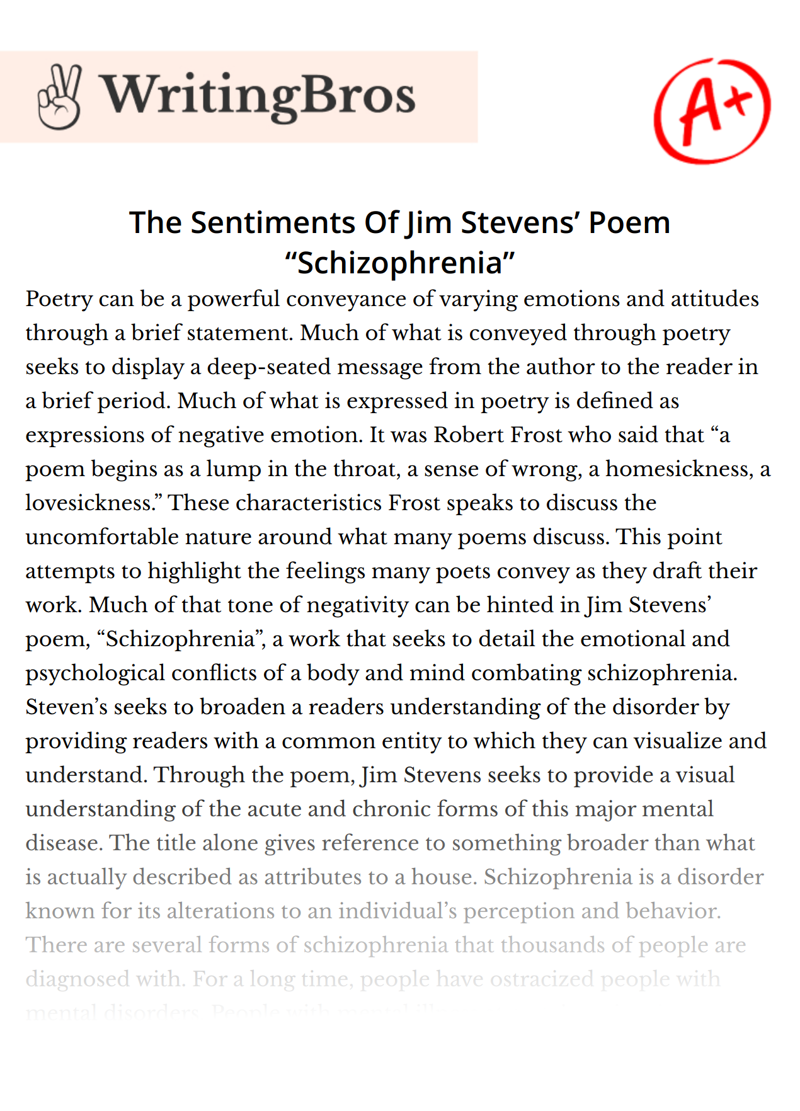The Sentiments Of Jim Stevens’ Poem “Schizophrenia”

Poetry can be a powerful conveyance of varying emotions and attitudes through a brief statement. Much of what is conveyed through poetry seeks to display a deep-seated message from the author to the reader in a brief period. Much of what is expressed in poetry is defined as expressions of negative emotion. It was Robert Frost who said that “a poem begins as a lump in the throat, a sense of wrong, a homesickness, a lovesickness.” These characteristics Frost speaks to discuss the uncomfortable nature around what many poems discuss. This point attempts to highlight the feelings many poets convey as they draft their work. Much of that tone of negativity can be hinted in Jim Stevens’ poem, “Schizophrenia”, a work that seeks to detail the emotional and psychological conflicts of a body and mind combating schizophrenia. Steven’s seeks to broaden a readers understanding of the disorder by providing readers with a common entity to which they can visualize and understand. Through the poem, Jim Stevens seeks to provide a visual understanding of the acute and chronic forms of this major mental disease.
The title alone gives reference to something broader than what is actually described as attributes to a house. Schizophrenia is a disorder known for its alterations to an individual’s perception and behavior. There are several forms of schizophrenia that thousands of people are diagnosed with. For a long time, people have ostracized people with mental disorders. People with mental illness at certain points in time would be convicted of crimes that were attributed to their illness. Rather than center the disorder to a single person within the poem, Stevens centers it on a decaying house. The house is a victim. The house is not the one suffering from the symptoms of changes but by the effect of those changes by the unknown residents of the house. Stevens maintains regular use of personification by establishing the character of his thread as a house versus a human being. The house is attributed with varying traits and characteristics that humans possess. The house “that suffered most” (Stevens 1) and “miss the shouting voices” (Stevens 9) indicates that the house can somehow become emotional to changes after the events mention. The events described within the home are unsettled. The speaker refers to the house rundown with “cracking pain, broken windows” (Stevens 16) giving way to the sentiment that the house has not been given much attention, been ignored. The “lines were drawn, borders established” (Stevens 12) reflect the growing of pains of the house’s internal conflict as it “divided against itself” and displaying a real characteristic of the delusional disorder. Much of what consists of the lifestyle of many schizophrenics is handling their minds breakaway from reality.
Stevens’ approach to the subject stands out by conveying that, in a way, the house is losing its battle of sanity. The people who regularly witnessed the house begin to fracture upon itself unambiguously refer to it as the “madhouse” (Stevens 19). Much of this matches with the commonality found among people who are schizophrenic, paranoia. This condition of delusional persecution was clear when “Certain doors were locked at night” (Stevens 5) to ensure the comfort of the suffering house. However, much inclination allows the reader to draw conclusions about the internal conflict of those living within the house.
The sentiment of Stevens’ work is clearly highlighted with a tone of darkness surrounding the stigma of how people feel and act towards people suffering from schizophrenia. The overall sense of conveyance allows the reader to conclude that it was not an actual house suffering the most but, in reality, the mind of a man or group of people with similar conditions suffering from a splitting mind. The connotation of the house more so comes to identify the occupants of the house are the true subjects of the story. The devolvement of the tenants is causing the atmosphere of the house to change. Overall, the sentiment of Stevens’ poem indicates a strong sense of negativity and aggression surrounding the events. This correlates with Frost’s statement around the understanding of how the poem conveys the sense of sorrow and anguish but in the end, reveal a deeper meaning by the literal denotation.
References
- Stevens, J. (2000). Schizophrenia. The Norton Anthology of Modern and Contemporary Poetry, 3, 1747-1748.
- O'Callaghan, E., Turner, B. J., Renwick, L., Jackson, D., Sutton, M., & Hockley, J. (2017). The experience of living with schizophrenia: a systematic review and meta-synthesis. Social psychiatry and psychiatric epidemiology, 52(12), 1433-1446.
- Corcoran, C., & Clarke, M. (2010). The experiences of recovery from schizophrenia: a meta-ethnographic review. Journal of mental health, 19(6), 527-542.
- Bola, J. R., Lehtinen, K., & Cullberg, J. (2009). Family interventions in schizophrenia: meta-analysis of randomized controlled trials. The British Journal of Psychiatry, 194(2), 97-107.
- Breier, A., & Buchanan, R. W. (2012). The treatment of schizophrenia: a review of current guidelines. Current opinion in psychiatry, 25(5), 457-463.
Cite this Essay
To export a reference to this article please select a referencing style below

